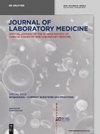Blood indices and circulating tumor cells for predicting metastasis of hepatocellular carcinoma after liver transplantation
IF 1.8
4区 医学
Q4 MEDICAL LABORATORY TECHNOLOGY
引用次数: 0
Abstract
Objectives Liver transplantation (LT) can benefit the long-term survival of hepatocellular carcinoma (HCC) patients. We hypothesized that circulating tumor cell (CTC) levels and subtypes are intimately associated with metastasis status of HCC patients. This study was designed to test that compositive hematological indices including CTC can provide a prediction of post-LT metastasis. Methods Between 2017 and 2018, 37 HCC patients within Hangzhou criteria receiving LT were included for analysis. The 24-month follow-up was mainly conducted by outpatient and telephone. Blood samples were collected, and hematological indices were examined. The outcomes such as PFS, recurrence, metastasis, location of recurrence/metastasis, and number of metastases were recorded. Results The follow-up analysis showed that microvascular invasion (MVI) classification at the baseline is associated with metastasis. Next, α-fetoprotein (AFP) level was another useful indicator of postoperative metastasis, especially at the third or fourth month; the protein induced by vitamin K absence or antagonist-II (PIVKA-II) level three months after LT was significantly higher for those who had later metastasis. The mesenchymal CTC level at the 45th day was increased for in the metastasis group. Using two-ends Logistic regression, the calculated value MP (metastasis predictor, by above factors). Had an AUC of 0.858 in the ROC curve, with a cutoff value of 0.328. Conclusions In conclusion, microvascular invasion, AFP level at the third or fourth month, PIVKA-II level at the third month, and mesenchymal CTC level at day 45 were associated with post-LT metastasis. Using Logistic regression based on above variables, the two-year metastasis can be predicted with satisfactory sensitivity and accuracy.血液指标和循环肿瘤细胞对肝移植后肝癌转移的预测
目的肝移植有利于肝细胞癌患者的长期生存。我们假设循环肿瘤细胞(CTC)水平和亚型与HCC患者的转移状态密切相关。本研究旨在检验包括CTC在内的综合血液学指标能否预测肝移植后转移。方法2017年至2018年,纳入37例符合杭州标准接受肝移植的HCC患者进行分析。随访24个月,主要通过门诊和电话方式进行。采集血样,检查血液学指标。记录PFS、复发、转移、复发/转移部位、转移数等预后。结果随访分析显示,基线时微血管侵犯(MVI)分级与转移相关。其次,α-胎蛋白(AFP)水平是术后转移的另一个有用指标,特别是在第3或第4个月;在肝转移后3个月,缺乏维生素K或拮抗剂ii (PIVKA-II)水平诱导的蛋白在发生肝转移后显著升高。转移组第45天间充质CTC水平升高。采用两端Logistic回归计算上述因素的转移预测值MP。ROC曲线的AUC为0.858,截断值为0.328。结论微血管浸润、第3、4个月时AFP水平、第3个月时PIVKA-II水平、第45天时间充质CTC水平与lt转移有关。基于以上变量,采用Logistic回归方法预测2年转移,具有较好的敏感性和准确性。
本文章由计算机程序翻译,如有差异,请以英文原文为准。
求助全文
约1分钟内获得全文
求助全文
来源期刊

Journal of Laboratory Medicine
Mathematics-Discrete Mathematics and Combinatorics
CiteScore
2.50
自引率
0.00%
发文量
39
审稿时长
10 weeks
期刊介绍:
The Journal of Laboratory Medicine (JLM) is a bi-monthly published journal that reports on the latest developments in laboratory medicine. Particular focus is placed on the diagnostic aspects of the clinical laboratory, although technical, regulatory, and educational topics are equally covered. The Journal specializes in the publication of high-standard, competent and timely review articles on clinical, methodological and pathogenic aspects of modern laboratory diagnostics. These reviews are critically reviewed by expert reviewers and JLM’s Associate Editors who are specialists in the various subdisciplines of laboratory medicine. In addition, JLM publishes original research articles, case reports, point/counterpoint articles and letters to the editor, all of which are peer reviewed by at least two experts in the field.
 求助内容:
求助内容: 应助结果提醒方式:
应助结果提醒方式:


